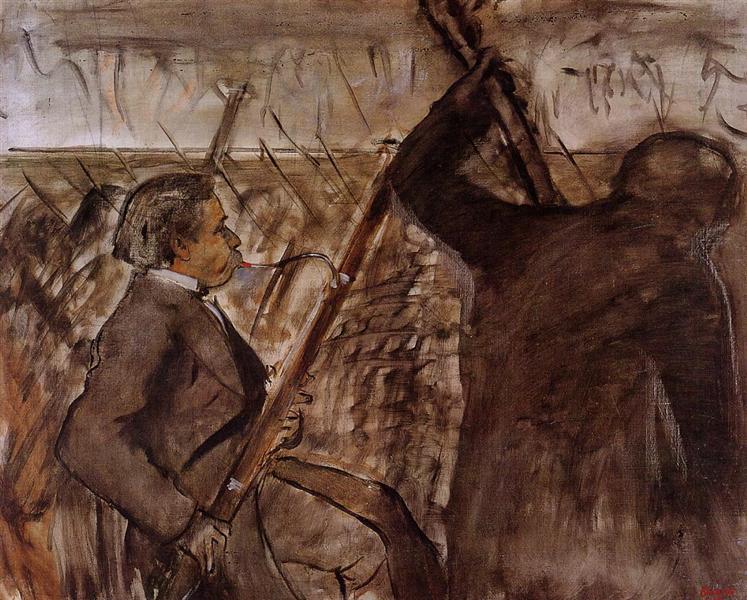Description
Edgar Degas's "Musicians of the Orchestra," painted in 1870, is a magnificent example of his ability to capture transitory moments of everyday life and human experience. In this work, Degas presents us with a scene that combines his interest in music and dance, recurring themes in his work, in a context that evokes both the intimacy of rehearsal and the energy of a live performance.
The composition of the painting is dynamic and enveloping. Degas employs a perspective that suggests an almost unusual point of view. He invites us to view the musicians from behind the conductor, providing a privileged view of the orchestral ensemble. This approach defies convention by removing the focus from the audience and concentrating it on the performers, a choice that reflects the artist's desire to explore the essence of musical art. The orchestra, in the foreground, is arranged in an arrangement that denotes both harmony and individuality. Each musician, although part of a collective, seems to be immersed in his or her own world, imbuing the work with an air of individuality within the unity.
The colours used by Degas are subtle and velvety, with a predominance of dark and muted tones that reflect the atmosphere of a concert hall. The shades of brown, grey and green that permeate the scene provide a feeling of warmth, while the bright flashes on the instruments and the musicians' clothing create a visual counterpoint that attracts the eye. The attention to detail in shapes and textures, especially in the string and wind instruments, demonstrates Degas' mastery in depicting the materiality and essence of objects.
Although there are no dancers in this work, as is common in many of Degas's works, the musicians can be considered in a figurative sense as dancers to the music, playing their part in a choreographed sound. This metaphor underscores the intrinsic relationship between the visual arts and music, a connection that Degas explored throughout his career. The musicians, with poses that suggest effort and concentration, seem to be engaged in a dialogue both with their companions and with the music itself.
It is interesting to note that "Musicians of the Orchestra" immerses the viewer in an almost introspective experience, reflecting Degas's fondness for capturing the vulnerability and essence of his subjects. What could be interpreted as a study of the lives of musicians is, in fact, a meditation on the dedication and passion that persists behind each musical performance.
Degas' work, marked by his involvement with the Impressionist movement, also challenges some of its conventions. While his contemporaries sought to capture the fleeting moment and changing light, Degas often opted for a more structured, composed and deliberate representation, as is evident in "Musicians of the Orchestra." This piece is part of a series of works in which the artist investigates the relationship between the fleeting moments of life and their representation through painting.
In short, “Musicians of the Orchestra” is a work that transcends its container, evoking emotion and reflection. Degas, with his singular technique and distinctive approach, succeeds in not only depicting musicians in action, but also in crafting a narrative about music and art in 19th-century urban life. The work stands as a testament to the power of music, not only to be heard, but to be lived and experienced through visuality.
KUADROS ©, a famous painting on your wall.
Hand-made oil painting reproductions, with the quality of professional artists and the distinctive seal of KUADROS ©.
Painting reproduction service with satisfaction guarantee. If you are not completely satisfied with the replica of your painting, we will refund 100% of your money.

